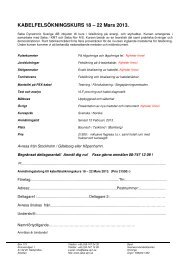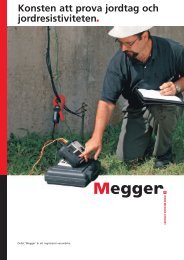A practical guide to earth resistance testing - Weschler Instruments
A practical guide to earth resistance testing - Weschler Instruments
A practical guide to earth resistance testing - Weschler Instruments
You also want an ePaper? Increase the reach of your titles
YUMPU automatically turns print PDFs into web optimized ePapers that Google loves.
One particular observation on the Slope Method is that if the calculation of µ<br />
is greater than that given in the table, the distance C must be increased.<br />
Secondly, before the measured values for R1, R2 and R3 can be accepted<br />
with a degree of confidence, it is recommended that a curve be plotted<br />
which will identify any localized effects and eliminate uncharacteristic<br />
readings from the calculations. Thirdly, it is also suggested that the test be<br />
repeated in different directions and with different spacings. The various<br />
results should exhibit a reasonable degree of agreement.<br />
Table VII: Values of D P<br />
/D c<br />
for Various Values of µ<br />
µ D P<br />
/D c<br />
µ D P<br />
/D c<br />
µ D P<br />
/D c<br />
0.40 0.643 0.80 0.580 1.20 0.494<br />
0.41 0.642 0.81 0.579 1.21 0.491<br />
0.42 0.640 0.82 0.577 1.22 0.488<br />
0.43 0.639 0.83 0.575 1.23 0.486<br />
0.44 0.637 0.84 0.573 1.24 0.483<br />
0.45 0.636 0.85 0.571 1.25 0.480<br />
0.46 0.635 0.86 0.569 1.26 0.477<br />
0.47 0.633 0.87 0.567 1.27 0.474<br />
0.48 0.632 0.88 0.566 1.28 0.471<br />
0.49 0.630 0.89 0.564 1.29 0.468<br />
0.50 0.629 0.90 0.562 1.30 0.465<br />
0.51 0.627 0.91 0.560 1.31 0.462<br />
0.52 0.626 0.92 0.558 1.32 0.458<br />
0.53 0.624 0.93 0.556 1.33 0.455<br />
0.54 0.623 0.94 0.554 1.34 0.452<br />
0.55 0.621 0.95 0.552 1.35 0.448<br />
0.56 0.620 0.96 0.550 1.36 0.445<br />
0.57 0.618 0.97 0.548 1.37 0.441<br />
0.58 0.617 0.98 0.546 1.38 0.438<br />
0.59 0.615 0.99 0.544 1.39 0.434<br />
0.60 0.614 1.00 0.542 1.40 0.431<br />
0.61 0.612 1.01 0.539 1.41 0.427<br />
0.62 0.610 1.02 0.537 1.42 0.423<br />
0.63 0.609 1.03 0.535 1.43 0.418<br />
0.64 0.607 1.04 0.533 1.44 0.414<br />
0.65 0.606 1.05 0.531 1.45 0.410<br />
0.66 0.604 1.06 0.528 1.46 0.406<br />
0.67 0.602 1.07 0.526 1.47 0.401<br />
0.68 0.601 1.08 0.524 1.48 0.397<br />
0.69 0.599 1.09 0.522 1.49 0.393<br />
0.70 0.597 1.10 0.519 1.50 0.389<br />
0.71 0.596 1.11 0.517 1.51 0.384<br />
0.72 0.594 1.12 0.514 1.52 0.379<br />
0.73 0.592 1.13 0.512 1.53 0.374<br />
0.74 0.591 1.14 0.509 1.54 0.369<br />
0.75 0.589 1.15 0.507 1.55 0.364<br />
0.76 0.587 1.16 0.504 1.56 0.358<br />
0.77 0.585 1.17 0.502 1.57 0.352<br />
0.78 0.584 1.18 0.499 1.58 0.347<br />
0.79 0.582 1.19 0.497 1.59 0.341<br />
Appendix VI<br />
Four Potential Method<br />
The Four Potential Method is another method based on fall-of-potential<br />
that allows the user <strong>to</strong> overcome the problems posed by complex<br />
grounding systems where the electrical center of the ground system is<br />
difficult <strong>to</strong> locate. This method was first introduced by Dr. G.F. Tagg in a<br />
1964 IEE paper 15 . For the purpose of this booklet, we will cover the test<br />
method and the formulae by which the <strong>resistance</strong> of the ground system<br />
can be determined. The theory behind the method will not be covered,<br />
although it links the <strong>resistance</strong> values obtained by measurements at six<br />
different positions for the potential probe in four formulae with the true<br />
<strong>resistance</strong> (R ∞ ), which would occur with an infinite distance <strong>to</strong> the current<br />
probe.<br />
The test probes are set out as shown in Figure 32, with measurement<br />
made from the edge of the electrical system. The current probe is set a<br />
suitable distance away from the edge of the ground system. The potential<br />
probe is then placed at distances equal <strong>to</strong> 20%, 40%, 50%, 60%, 70%<br />
and 80% of the distance <strong>to</strong> the current probe and a test is made at each<br />
location. The <strong>resistance</strong> values obtained (R 1 , R 2 , R 3 , R 4 , R 5 , and R 6 ) are<br />
then entered in<strong>to</strong> four formulae.<br />
The formulae used follow:<br />
1] (R ∞ ) = -0.1187R 1 – 0.4667R 2 + 1.9816R 4 – 0.3961R 6<br />
2] (R ∞ ) = -2.6108R 2 + 4.0508R 3 – 0.1626R 4 – 0.2774R 6<br />
3] (R ∞ ) = -1.8871R 2 + 1.1148R 3 + 3.6837R 4 – 1.9114R 5<br />
4] (R ∞ ) = -6.5225R 3 + 13.6816 R 4 – 6.8803R 5 + 0.7210R 6<br />
15 Reference 24 (page 77)<br />
64 1-866-254-0962 www.megger.com Getting Down <strong>to</strong> Earth 65




